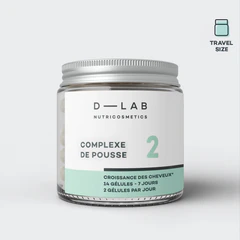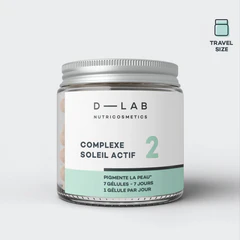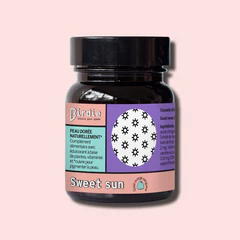Le soleil, avec ses rayons chauds et brillants, nous invite souvent à profiter des plaisirs de la saison estivale. Cependant, il est essentiel de se rappeler que le bronzage n'est pas seulement une question d'apparence, mais aussi de santé.
Excessive exposure to ultraviolet (UV) rays can lead to serious skin problems, such as sunburn, premature skin aging and even skin cancer.
That's why it's crucial to take steps towards safe, responsible tanning.
I. Understanding the dangers of the sun
1. The harmful effects of UV rays on the skin
When we're enjoying the warm rays of the sun, it's essential to understand the damaging effects that ultraviolet (UV) rays can have on our skin. UV rays are invisible to the naked eye, but they can cause considerable damage. The two main types of UV rays are UVA and UVB.
UVA rays are present all year round and can penetrate deep into the skin. They are responsible for premature aging of the skin, altering elasticity and firmness, and promoting the appearance of fine lines and wrinkles. UVA rays are also associated with the formation of age spots and other pigmentation problems. It's important to note that UVA rays can penetrate windows and be present even on cloudy days, meaning we're exposed to them even when we're indoors.
UVB rays are most intense during the summer months and are the main cause of sunburn. They penetrate the upper layers of the skin and stimulate melanin production, giving the skin a tan. However, excessive exposure to UVB rays can lead to painful sunburn, redness, itching and peeling of the skin. UVB rays are also a major risk factor for skin cancer, as they damage the DNA of skin cells. It is therefore essential to protect yourself from UVB rays to prevent sunburn and reduce the risk of skin cancer.
2. The difference between UVA and UVB rays
It's important to understand the difference between UVA and UVB rays. UVA rays are present all year round and can penetrate deep into the skin. They are responsible for premature aging of the skin and can penetrate windows and even clouds. UVA rays are often associated with the formation of wrinkles, age spots and other signs of long-term skin damage. UVB rays, on the other hand, are most intense during the sun's peak hours, and are the main cause of sunburn. They penetrate the upper layers of the skin and are a major risk factor for skin cancer. It is essential to protect yourself from both types of radiation by using appropriate sun protection methods.
By understanding the harmful effects of UV rays on our skin, such as the risk of sunburn, premature aging and skin cancer, we can take steps to protect ourselves effectively from the sun. Prevention is the key to maintaining healthy skin and preventing long-term health problems.

3. Risks of sunburn, premature skin ageing and skin cancer
One of the most common risks of excessive sun exposure is sunburn. When skin is exposed to UV rays beyond its natural protective capacity, it becomes red, painful and may even swell. Sunburn is not only painful, it also indicates that the skin has suffered significant damage. Repeated sunburn over time can increase the risk of developing skin cancer.
In addition to sunburn,prolonged unprotected exposure to the sun can lead to premature aging of the skin. UV rays accelerate the skin's natural aging process by damaging the collagen and elastin fibers responsible for its firmness and elasticity. The result is sagging, wrinkled skin with age spots.
II. Preparing your skin before exposure
Preparing your skin before exposure to the sun is a crucial step in ensuring optimum protection. There are several steps you can take to effectively prepare your skin before exposure to the sun.
1. The importance of moisturizing and exfoliating to eliminate dead skin cells
Moisturizing the skin is a fundamental step in maintaining its health and suppleness. Well-hydrated skin is more resistant to sun damage and has a better capacity to regenerate. Before exposing ourselves to the sun, it's crucial to ensure that our bodies are sufficiently hydrated from the inside out, by drinking an adequate amount of water throughout the day. Water helps keep the skin hydrated internally, which is crucial for healthy, glowing skin. In addition, regular application of a moisturizing cream suited to our skin type is essential. Moisturizers help prevent skin dehydration, maintain elasticity and reinforce the skin's protective barrier. We recommend opting for light, non-comedogenic formulas that easily penetrate the skin without clogging pores. A well-moisturized skin is better prepared to face the sun's aggressions.
Skin exfoliation is an often overlooked but essential step in effectively preparing our skin for sun exposure. Exfoliation removes dead cells and impurities accumulated on the skin's surface. This promotes healthy cell renewal and better absorption of sun protection products. When we exfoliate our skin, we also stimulate blood circulation, which contributes to healthier, more radiant skin. We recommend using a gentle exfoliator suited to our skin type. For the face, it's best to opt for specific scrubs designed for this more delicate area. For the body, exfoliants based on sea salts or sugar are often effective. Exfoliation should be carried out once or twice a week to maintain smooth skin and prepare it for an even tan.

2. Use a sun cream adapted to your skin type
For effective sun protection, it's crucial to use a sun cream that's adapted to your skin type. Each skin type has its own needs and sensitivities, so it's essential to choose a sun cream that matches these specificities. People with dry skin can opt for sun creams formulated with moisturizing agents to prevent skin dehydration. Sensitive skin can benefit from gentle, hypoallergenic sun creams that reduce the risk of irritation. Oily skin can benefit from light, non-comedogenic formulas to avoid clogged pores. Tinted or mattifying sun creams can also be an option for controlling shine.
It's also important to consider the sun protection factor (SPF) for your skin type. Lighter, more sensitive skins generally require a higher SPF for optimum protection against UV rays. Darker skins can opt for a slightly lower SPF, but it's still essential to use adequate protection.
When applying sunscreen, it's important to apply it generously and evenly to all exposed parts of the body, including the face, arms, legs and sensitive areas such as the neck and shoulders. Reapplication is recommended every two hours, especially after swimming or perspiring excessively. By choosing the right sunscreen for your skin type and applying it correctly, you can enjoy effective sun protection and reduce the risk of damage caused by UV rays.
3. Sun food supplements
Taking dietary supplements before exposure to the sun can be beneficial in boosting our skin's protection and promoting a healthy tan. Some dietary supplements contain specific ingredients that can help prepare the skin from within and minimize damage caused by UV rays.
For a golden complexion by avoiding overexposurewe recommend the Duo Pro-Solaire composed of our Active Sun Complex as well as our Melanin absolute.
This ultra-complete duo offers 360° action, with the Active Sun Complex providing active ingredients to stimulate melanin synthesis to prepare, activate and prolong tanning while protecting the skin, and the Melanin Absolute directly supplying melanin, ready for use - the body doesn't need to synthesize it, it's supplied directly!
For immediate and reinforced action when exposed to the sun. You'll tan 4x faster!
For sensitive skin, we recommend that you combine the Skin Calming Complex to your treatment Pro-Solairewhich protects skin from photoaging thanks to the antioxidant properties of SOD and soothes inflammation with turmeric for reduce redness and avoid reactions.
Patented, clinically proven antioxidant and anti-inflammatory properties.
How to tan when you have white skin?
The Skin Calming Complex is a complex of innovative active ingredients renowned for soothe and protect reactive skin, reduce inflammation and densify sensitive skin. The must-have for comfortable skin every day!
CALMS REDNESS & SOOTHES SKIN
Roman chamomile flower extract, four times more concentrated in active ingredients than the dry plant, effectively reduces redness and soothes itchy skin.
As for turmeric, it acts as a powerful natural anti-inflammatory and antioxidant, relieving skin inflammation and redness, while maintaining skin health.
PROTECTS & PLUMPS SKIN
Hydration and protection are essential for radiant skin. That's why this formula combines renowned active ingredients to help you regain supple, protected skin.
Microencapsulated zinc and copper, the minerals in this formula, contribute to protect cells against oxidative stress. Acerola extract, rich in native vitamin C at six times the concentration found in juice, awakens skin cells, protects against external aggression and contributes to collagen formation, guaranteeing normal skin function.
SuperOxide Dismutase (SOD) from Provence melon, with its concentration 37 times higher than that of pure melon, is renowned for protecting the skin from external aggressionespecially from UV rays. Powerful antioxidants such as zinc, native vitamin C, turmeric, SOD and hemp oil are integrated into this formula to combat oxidative stress and effectively protect the skin from external aggressors.
Finally, hemp oilthanks to its moisturizing properties, plays an active role in maintaining healthy skin.
The Active Sun Complex naturally colours the skin, intensifies tanning and protects skin from the sun's harmful rays.
Skin is tanned, soft and sublime. Complexe Soleil Actif is a "complex", which means it provides a wide range of active ingredients - 10 to be precise - that work together to prepare, activate and prolong tanning, while protecting the skin.
The skin is therefore ready to defend itself from UV rays and to avoid any form of reaction like summer lucites (allergies).
We've selected a powerful pomegranate extract, patented and scientifically tested for its anti-ageing effects on the skin.
This extract is very rich in punicalagin polyphenols (titrated at 30%), helping to regenerate skin cells, tighten skin texture and prevent the formation of wrinkles.
It also significantly reduces hyperpigmentation and brown spots caused by overexposure to the sun.
We recommend that you start this treatment at least 15 days (preferably 1 month) before your first exposure, continue it during the exposure period and extend the treatment at least 15 days after your return to reinforce the protective effect and maintain your tanned complexion.
LMelanin Absolute offers your skin a higher concentration of melanin, which is ready to use straight away for a stronger tan and optimum protection!
For immediate and reinforced action during exposure. You'll be able to tan 4x faster while providing real antioxidant protection to combat the free radicals created by UV rays.

III. Protecting your skin during exposure to the sun
Protecting your skin during sun exposure is crucial to preventing UV damage and maintaining healthy skin. There are several steps you can take to ensure effective protection against the sun.
1. Choose the right exposure times
First of all, it's essential to choose the right exposure times. UV rays are most intense between 10 am and 4 pm. During this period, it's best to limit your time in the sun, as your skin is more likely to burn. If possible, plan your outdoor activities for early morning or late afternoon, when the sun's rays are less intense.
2. Wear protective clothing and accessories
Next, wear protective clothing and accessories to cover your skin as much as possible. Opt for long garments, preferably in tight-fitting, dark-colored fabrics, which offer better protection against UV rays. Wide-brimmed hats are also essential to protect your face, neck and shoulders from the sun. Don't forget to protect your eyes by wearing sunglasses that block UVA and UVB rays.
3. Reapply sunscreen regularly
Finally, regular reapplication of sunscreen is essential to maintain effective protection. Reapply sunscreen generously every two hours to all exposed parts of your body, and more frequently if you're swimming or sweating profusely.

IV. Taking care of your skin to preserve your tan
1. Soothe skin with after-sun products
After a day in the sun, it is important tosoothe the skin in order to minimize redness and irritation. The after-sun products are specially formulated to provide instant relief and help repair damage caused by UV rays. They often contain soothing ingredients such as aloe vera, chamomile or cucumber extract. Generously apply an after-sun product to your skin to calleviate sensations of overheating and promote cell regeneration.
2. Deeply moisturize skin
Prolonged exposure to the sun can lead to skin dehydration. So it's crucial to restore deep hydration. Opt for moisturizing creams or lotions rich in humectants such as hyaluronic acid or glycerine. These ingredients help retain moisture in the skin, making it softer and more supple. Apply moisturizer generously all over the body, concentrating on particularly dry or sun-exposed areas such as the face, arms and legs.
To conclude
In conclusion, it's essential to understand the dangers of the sun and the harmful effects of UV rays on our skin. Excessive exposure can lead to serious skin problems such as sunburn, premature skin aging and skin cancer. To enjoy a safe and responsible tan, it's important to take protective measures.
Before exposure, we recommend moisturizing and exfoliating the skin to maintain its elasticity and eliminate dead cells. The use of a sun cream adapted to your skin type is crucial for effective protection. It is also possible to take melanin-based dietary supplements to naturally stimulate the production of this pigment and achieve a faster tan while reducing the risks.
During exposure, it's essential to protect yourself by wearing light clothing and a hat, avoiding direct exposure during the hottest hours, and reapplying sunscreen regularly.
By adopting these preventive and protective measures, we can enjoy the pleasures of the summer season while preserving the health of our skin. Remember, safe and responsible tanning is the key to maintaining healthy skin and preventing long-term health problems.







